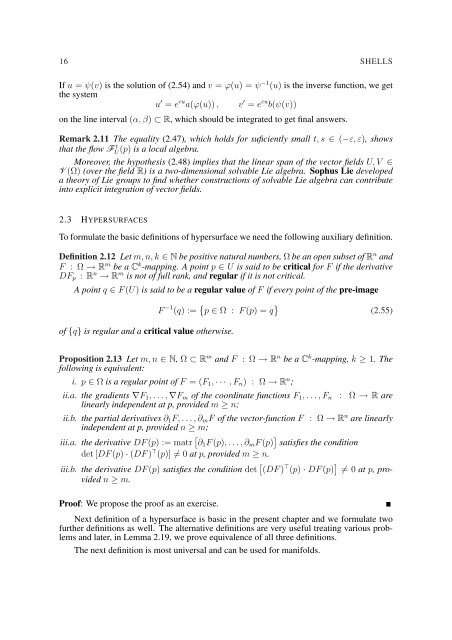EQUATIONS OF ELASTIC HYPERSURFACES
EQUATIONS OF ELASTIC HYPERSURFACES
EQUATIONS OF ELASTIC HYPERSURFACES
Create successful ePaper yourself
Turn your PDF publications into a flip-book with our unique Google optimized e-Paper software.
16 SHELLS<br />
If u = ψ(v) is the solution of (2.54) and v = ϕ(u) = ψ −1 (u) is the inverse function, we get<br />
the system<br />
u ′ = e cu a(ϕ(u)) , v ′ = e cu b(ψ(v))<br />
on the line interval (α, β) ⊂ R, which should be integrated to get final answers.<br />
Remark 2.11 The equality (2.47), which holds for suficiently small t, s ∈ (−ε, ε), shows<br />
that the flow FU t (p) is a local algebra.<br />
Moreover, the hypothesis (2.48) implies that the linear span of the vector fields U, V ∈<br />
V (Ω) (over the field R) is a two-dimensional solvable Lie algebra. Sophus Lie developed<br />
a theory of Lie groups to find whether constructions of solvable Lie algebra can contribute<br />
into explicit integration of vector fields.<br />
2.3 <strong>HYPERSURFACES</strong><br />
To formulate the basic definitions of hypersurface we need the following auxiliary definition.<br />
Definition 2.12 Let m, n, k ∈ N be positive natural numbers, Ω be an open subset of R n and<br />
F : Ω → R m be a C k -mapping. A point p ∈ U is said to be critical for F if the derivative<br />
DF p : R n → R m is not of full rank, and regular if it is not critical.<br />
A point q ∈ F (U) is said to be a regular value of F if every point of the pre-image<br />
of {q} is regular and a critical value otherwise.<br />
F −1 (q) := { p ∈ Ω : F (p) = q } (2.55)<br />
Proposition 2.13 Let m, n ∈ N, Ω ⊂ R m and F : Ω → R n be a C k -mapping, k ≥ 1. The<br />
following is equivalent:<br />
i. p ∈ Ω is a regular point of F = (F 1 , · · · , F n ) : Ω → R n ;<br />
ii.a. the gradients ∇F 1 , . . . , ∇F m of the coordinate functions F 1 , . . . , F n : Ω → R are<br />
linearly independent at p, provided m ≥ n;<br />
ii.b. the partial derivatives ∂ 1 F, . . . , ∂ m F of the vector-function F : Ω → R n are linearly<br />
independent at p, provided n ≥ m;<br />
iii.a. the derivative DF (p) := matr [ ∂ 1 F (p), . . . , ∂ m F (p) ] satisfies the condition<br />
det [DF (p) · (DF ) ⊤ (p)] ≠ 0 at p, provided m ≥ n.<br />
iii.b. the derivative DF (p) satisfies the condition det [ (DF ) ⊤ (p) · DF (p) ] ≠ 0 at p, provided<br />
n ≥ m.<br />
Proof: We propose the proof as an exercise.<br />
Next definition of a hypersurface is basic in the present chapter and we formulate two<br />
further definitions as well. The alternative definitions are very useful treating various problems<br />
and later, in Lemma 2.19, we prove equivalence of all three definitions.<br />
The next definition is most universal and can be used for manifolds.

















